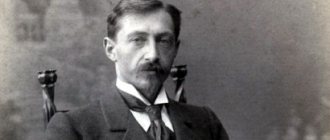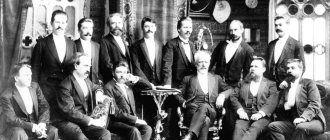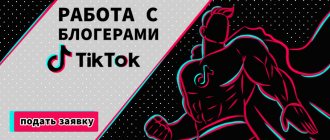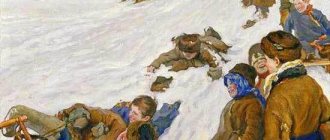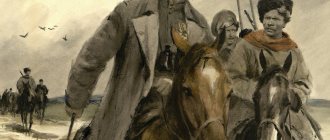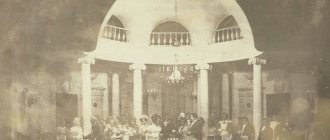History of creation
The fairy tale “The Pantry of the Sun” was written in about a month and completed in early June 1945. Prishvin took part in the competition for the best book for children, announced by the Ministry of Education of the RSFSR. Prishvin won the competition, and the work was published in the magazine “October” No. 7 for 1945.
From 1941 to 1945 Prishvin was evacuated to the village of Usolye, Yaroslavl region, where he protested against deforestation by peat miners. There he observed the life of orphans, ten-year-old Sonya and eleven-year-old Bori, who successfully managed the household. They became the prototypes of 12-year-old Nastya and 10-year-old Mitrasha.
Prishvin did not have a clear plan, initially intending to describe how the children quarreled in the forest and went to collect cranberries along different paths. The further plot developed by itself during the writing process.
Prishvin thought about the name for a long time. Either he wanted to name the story by the nicknames of the main characters (“The Golden Hen and the Little Man in the Pouch”), by their relationships (“Friends”), then by the location of the action (“Path of Tests,” “Fornication Swamp”), or by the issue (“Friends”). Pravda Antipych", "Friend of Man"). The metaphor “Pantry of the Sun” was not invented by Prishvin. He found this exact expression in a study about swamps, where they were called so because they stored solar fire and heat contained in plants.
Images of human friend and enemy
M. M. Prishvin in the fairy tale “The Pantry of the Sun” raises an important issue of the relationship between man and nature. When Mitrash finds himself in danger, nature frowns; when he is freed from the swamp, the world around him rejoices along with the hero. Blind Yelan is a real enemy not only for Mitrasha, but also for other people who could not escape.
The work contains two integral images of the animal world: the dog Grass and the wolf Gray Landowner. The grass is the personification of nature's friendship with man. The wolf is called the enemy of man several times in the story.
The dog, devoted to its owner Antipych, cannot come to terms with his death. She is looking for her beloved owner in all people. This saves Mitrasha from death. It was thanks to Grass that the hero managed to get out of the swamp.
The wolf is described as a cunning animal that no one can catch. Among the wolves in those parts, only the Gray Landowner remained. For the villagers, he was a real enemy, because “in one summer he slaughtered cows and sheep no less than a whole flock had slaughtered them before.” The narrator several times calls the wolf the enemy of man.
The images of a dog and a wolf are sharply opposed to each other. They are in different relationships with a person.
Literary direction and genre
Prishvin gave the genre definition of “The Pantry of the Sun” himself, calling it a fairy tale. This is not a connection in the genre definition of two antonyms. The realist Prishvin believed that his “things” were more than fairy tales, because they “turn reality into a fairy tale.” Thus, it is written “a fairy tale contained in the categories of space and time,” “a fairy tale without Ivan Tsarevich and Baba Yaga,” “a new fairy tale that would live in real life.”
The eternal values that are glorified in fairy tales also prevail in the modern fairy tale. Prishvin considered himself a modern storyteller.
Theme, main idea and composition
This story is about the connection between man and nature, about true humanity, which makes man the king of nature, the patron of all living things on earth, a friend to all living things. The main idea is the glorification of friendship and collectivism. Of course, the idea is connected with victory in the war, which at the time the story takes place, in 1942, was only a hope. Prishvin introduces the image of friend and enemy, this is a dog, “man’s most faithful friend,” and a wolf, “his worst enemy, doomed to death by his very malice.” This is an image of the fascists, although neither them nor the military operations are mentioned in the story.
The title seems to have no connection with the theme or the main idea, but simply indicates the location of the action. But this is not so, because the sun is the friend and deity of all living things, its storehouse - dead herbs lying close to each other - is a symbol of camaraderie and even brotherhood.
The story consists of 12 parts. The first part acts as an exposition, telling about the good working life of orphaned children. The second part is the beginning. It tells how in the spring children gathered for healthy cranberries that had overwintered under the snow. Mitrasha imitates his father in everything. He takes with him a compass, decoys to attract birds, and a double-barreled shotgun. Nastya, like a mother, takes a towel for the heavy basket, yesterday’s potatoes, bread and milk.
Mitrasha dreams of finding a blood-red Palestinian, that is, an untouched clearing full of cranberries. His father told him that she was located near the Blind Elani - an insidious swamp.
In the third part, the children come to the borina (pine forest in the middle of the swamp) Zvonkaya. They choose to follow an inconspicuous path to the north. In the fourth part the tension increases. Near the Lying Stone, where the children rest, several conflicts occur between trees, showing black grouse, black grouse and ravens. They seem to provoke a quarrel between the children, who argue about the path and disperse, while all the food supplies remain with Nastya.
The fifth part is a retrospective episode about the dog Travka, who lives in a potato pit near the lodge of Antipych, who died two years ago.
The sixth chapter is also retrospective and is devoted to the fight against wolves on the Sukhaya River, the “wolf fortress.” All the wolves were shot, fencing the hunting area with flags, so that they lost their “wolf sense”. And only the Gray landowner jumped over the flags and did this five more times. Since then he has killed more sheep than the entire pack of wolves. At the beginning of spring, the Gray landowner was angry and hungry. He heard Grass howl.
In the seventh chapter, the original plot resumes. The grass followed the hare's trail to the Lying Stone and decided to follow the children's trail first, smelling that it was Nastya who had food. So one day she found Antipych in the forest with her upper nose.
The eighth chapter is the climax. Mitrasha walked along a barely noticeable path to Blind Elani and decided to shorten the path, because the human path went to the left of the compass needle. The “little man” got stuck chest-deep in the swamp and called his sister, hearing her cry. But the wind was from the girl’s direction, and she did not hear her brother. Only magpies and crows anticipated his imminent death.
In the ninth chapter, the storylines of Nastya and Mitrasha converge, just as their paths should have converged in Palestine full of berries. Nastya's greed for sour cranberries awoke, and she filled the basket full, forgetting about food and her brother.
Having lost her human appearance, the forgotten Nastya woke up only after colliding with a snake. Reaching for bread for the arriving Grass, Nastya realized how much time had passed, and in desperation she called her brother. This is the same cry that Mitrash heard in chapter 8.
In the tenth chapter, Grass, howling for Nastya’s grief, heard the fox chasing a hare, and decided to catch it from under the fox, then she drove it to the Blind Elan.
In the eleventh chapter there is another climax: in pursuit of a hare, the grass ends up next to Mitrash, who calls it by name, recognizes Antipych in him and crawls up to the boy, unwittingly helping him get out of the swamp.
In the twelfth chapter there comes a happy ending. Mitrash prepares to kill the hare, but first kills the Gray landowner, whom he encountered in the bushes. Brother and sister are dating. In the morning, fellow villagers go out in search of them, but the children return to meet them with the loot. The neighbors did not immediately believe that Mitrash killed the wolf. He turns into a hero, and two years later he becomes a tall, handsome man. And Nastya gave all her cranberries to orphans from Leningrad, suffering from her greed. At the end, the narrator reveals his identity as a scout for swamp riches.
Heroes of the story
Nastya and Mitrash are orphans who are looked after by the entire village. Nastya is 12 years old, she looks like a Golden Hen on high legs, her hair is golden, her freckles are frequent and large, like gold coins, and her nose is clean and sticks up. Mitrasha is 2 years younger, stubborn and strong. He is short, but very dense, with a broad forehead and a wide nape. For his appearance, he received the nickname “Little Man in a Bag.” He also had a protruding nose and freckles.
From their parents, the children inherited a large farm (a cow, a heifer, a goat, sheep, chickens, a pig), and they coped with it very well. The narrator characterizes them as smart, friendly kids, ready to help with public works, so necessary during the war. The narrator treats children very warmly, like the rest of the village residents, and calls them our favorites.
The children worked tirelessly, just like adults. Nastya got up before dawn and busied herself with the housework until nightfall, fulfilling all her feminine duties. Mitrasha made wooden utensils, performed men's duties and took part in public affairs.
Mitrash is obstinate, his favorite saying is “here’s another.” But he is persistent and decides to follow the compass to the north at all costs.
The boy is smart, but he has little life experience. That is why he falls into a swamp trap, but survives not only thanks to the Grass, but also to his ingenuity. Nastya is hot-tempered, like her brother, although she is older. But she is only 12 years old, and she cannot always respond with affection to her brother’s stubbornness. Angry, she turns red as red, spits in her brother’s direction and forgets about him for the whole day. The girl is passionate about picking cranberries and fills a huge basket in a day. Nastya loses her cute appearance from greed for cranberries. She crawls around wet and dirty, the “former Golden Hen.” When Nastya woke up, she repented of her greed. And the transfer of cranberries to orphans from Leningrad was atonement for her misdeed, although no one except the narrator condemned her.
The dog Travka is a full-fledged hero of the story. She is endowed with a human soul. She had a grief, a terrible misfortune - the death of her owner. Grass is a red hound dog with a black strap across the back and black stripes under the eyes with a curve like glasses.
Grass, according to Antipych, understands everything better than people. The meaning of Travka’s life is to work for the owner; for him she caught hares. And after his death, the dog often forgot and brought hares to Antipych’s destroyed guardhouse.
For Travka, all of humanity was Antipych, only with different faces. With her howl, Grass called Antipych to her, it was a prayer for a person. Both brother and sister mispronounce her name. Nastya, by association, calls her Muravka, and Mitrasha calls her real name Zatravka, from which the beginning has disappeared. The grass responds to any of the names, just as it sees Antipych or his enemy in every person. She finds her owner, young Antipych - Mitrasha.
Antipych is like a magical sage. His age is unknown to anyone (more than 80 years and less than 100). It seemed to the narrator that Antipych would never die. Antipych is the keeper of the truth. The narrator is trying to find out this secret from him. But Antipych does not say where the truth is, but promises to whisper in the grass’s ear before his death. In Chapter 11, Prishvin realizes that this is the truth of the eternal struggle of people for love.
The story is written in the first person plural (we). This is a rare form of storytelling associated with the idea of the superiority of the collective over the individual.
Prishvin, Analysis of the work Pantry of the Sun, Plan
Analysis of the work
M. M. Prishvin entered literature not only as a talented writer, but also as an ethnographer, geographer, and cosmographer. However, his works were not in demand in Soviet society. Ideal for the literature of that time were works full of high civil and revolutionary pathos, saturated with the socialist slogans of those years. Prishvin’s work was considered an attempt to escape from real life, from solving pressing problems about building a bright future. Prishvin's discovery as a talented word artist took place only in recent decades. Today he is one of the most unsolved writers.
The nature of his native land had a huge influence on all his work. The future writer was born on the Khrushchevo estate. It was here that he learned to listen and hear the sounds of nature, its sometimes quiet and sometimes loud speech. Prishvin was very gifted with hearing “for the whistling of birds, the breathing of grass and the murmuring of animals.” He tried his best to convey the voice of nature, to translate it into human language. We are amazed at this ability of his while reading the story “The Pantry of the Sun.”
The plot of this work is quite simple. This is a story about the life and adventures of two little children who were left orphans in the difficult post-war years. But Prishvin wraps his characters in such a poetic shell that everything that happens becomes like a fairy tale. This is exactly the genre Prishvin chooses for his work - a fairy tale. The concept of “fairy tale” will become central in Prishvin’s work in the 20-50s. For the writer, this concept was a form of artistic storytelling in which he could freely embody his ideals and depict the immutable laws of nature. In “Pantry of the Sun” he creates the image of an ideal village where everyone lives peacefully, amicably, okay. And the small family - brother Mitrasha and sister Nastya - are everyone’s favorites, they are two little suns.
“Nastya was like a Golden Hen on high legs. Her hair, neither dark nor light, shimmered with gold, the freckles all over her face were large, like gold coins... <...>Only one nose was clean and looked up. Mitrasha was two years younger than his sister. <…> He was a stubborn and strong boy. “A little man in a bag,” the teachers at school called him smiling among themselves. “The little man in the bag,” like Nastya, was covered in golden freckles, and his nose, clean, like his sister’s, looked up.” The author lovingly describes his characters and gives them cute names. And this also somewhat resembles a fairy tale.
And so our little heroes set off on a long journey to a Palestinian woman, whom they know about from their father’s stories. This is reminiscent of the saying: “go there, I don’t know where.” Children find themselves in a huge fairyland, where every bush, every bird has the ability to speak and think. The author places us in the wonderful world of nature, while he tries with all his might to show the kinship of man with this natural world: “poor birds and little animals, how they all suffered, trying to pronounce some common, one beautiful word! And even children, as simple as Nastya and Mitrasha, understood their effort. They all wanted to say just one beautiful word. You can see how the bird sings on the branch, and every feather trembles with effort. But still, they cannot say words like we do, and they have to sing, shout, and tap.
- Tek-tek! - a huge capercaillie bird taps barely audibly in a dark forest.
- Shvark-shwark! — a wild drake flew in the air over the river.
- Quack-quack! - wild mallard duck on the lake.
“Gu-gu-gu... - a beautiful bullfinch bird on a birch tree.”
The author appears here as a person with a keen ear, capable of hearing and understanding the wonderful language of birds, plants and animals. Prishvin uses a wide variety of means of artistic expression. But the most important technique with the help of which the heroes of the natural world come to life on the pages of the work is personification. In the fairy tale, not only animals, but also birds and even trees had the ability to think. These are raven and crow talking, and cranes announcing the coming of the sun and its sunset, and the groan of fused pine and spruce.
Nature is not inactive, it actively comes to the aid of man. The old women-fir-trees also warn Mitrash about the trouble; they try in vain to block his path to the destructive fir-tree. And the black raven scares him with its cry. What can we say about the smart, quick-witted and devoted dog Travka!
Thus, the main theme in were - the theme of the unity of man and nature. In his works, Prishvin “condenses goodness,” he embodies his ideals and thereby calls on readers to goodness.
Plan
1. The friendly life of Nastya and Mitrasha in the village.
2. Children gather for cranberries.
3. The guys quarreled and went down different paths.
4. Nastya finds a Palestinian woman, all strewn with cranberries, and Mitrasha, due to her mistake, ends up in a swamp.
5. Forester Antipych’s dog Travka helps Mitrash out of trouble.
6. The little hunter kills the old wolf robber Gray Landowner, and the children return home.
Prishvin, Analysis of the work Pantry of the Sun, Plan
5 (100%) 1 vote
Searched on this page:
- sun pantry plan
- prishvin pantry of the sun analysis of the work
- sun pantry plan
- pantry of the sun analysis of the work
- analysis of the work pantry of the sun
